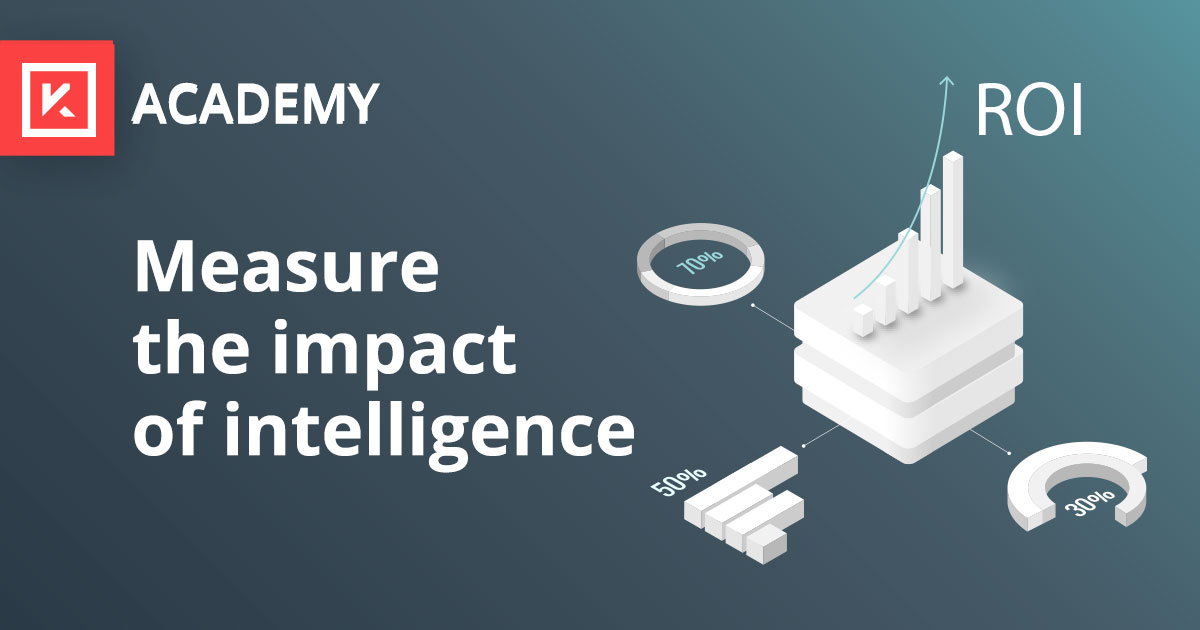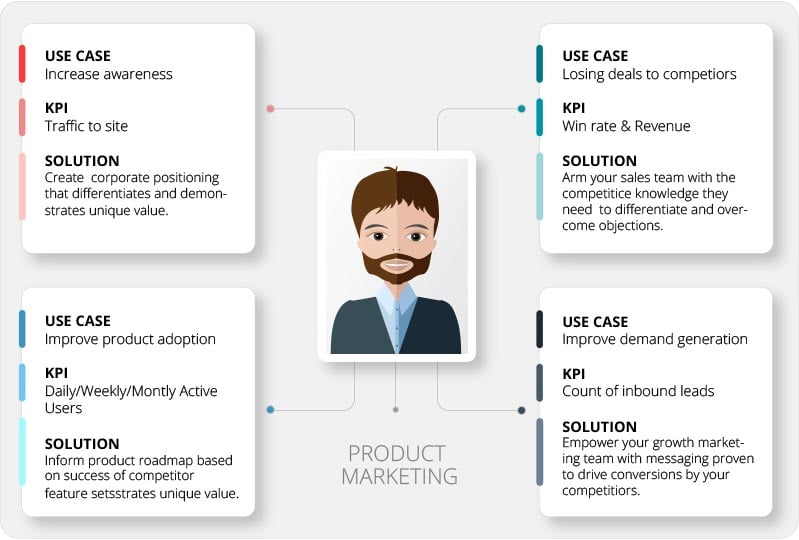How to Write a Meaningful Win Loss Analysis
Learn how to write a meaningful competitive win loss analysis that confirms your competitive advantage, disadvantage, and steps you can take to drive...
Learn how leading product, marketing and sales teams are measuring the effectiveness of their competitive intelligence initiatives with this article from Kompyte. 7-min read

Everyone in a competitive business knows that any piece of intel can be extremely valuable. Sometimes, even a small insight into a competitor’s offering can make the difference and drive (flows) of revenue to a certain player.
However, when it comes time to convince other stakeholders on the importance of investing resources in competitive intel, you might run into a hard time: everyone knows the value is out there, it’s just not that easy to explain.
Here’s a quick guide to easily measure and explain the ROI of any competitive initiative:
Intel alone has no value, you need another business process to benefit from it in order to understand how valuable it can be.
No matter how much time or resources you spend gathering intel into newsletters and reports, if no one in the organization is changing their behavior because of it, then your time and effort will be wasted. Period.
Also, if someone used the intel to make a great move but you didn’t measure it, you’ll never know how valuable your work was, and you’ll never be able to take credit for it.
Now, how can a competitive intelligence specialist make sure that their efforts are worthy and appreciated? Easy. By making sure they focus their efforts where the company needs it the most, and keeping track of its success.
Every organization has a priority in mind, something that needs to be fixed or improved with urgency. This could be sales conversions, social-media impact, product innovation, hiring, etc. Just make sure you know which KPI is most important to your company. Talk to the managers, board members, investors, and other influencers. Eventually, you will get to a few “north star” metrics.
The same piece of intel can positively impact multiple areas within the company, but putting a competitive initiative in place takes time and resources. By focusing on insights that impact the departments that are a priority, your chances of success will increase dramatically.

Let’s say that you identified that Sales is the priority. Marketing is generating leads, but looks like many of those leads are getting lost just before the purchasing stage. If you are in a competitive industry, these lost sales are most likely going to a competitor, and it’s time to take action.
First of all, figure out who in the company oversees the problem you are trying to solve, most likely a VP of Sales or someone in a similar role. That person should be your sponsor and advocate.
Then, make it very clear what your goals are so that he/she understands why it is so important to invest in intelligence. For now, just focus on the advantage. You can state a concrete benefit such as: “We’re putting in place a competitive initiative to help you increase your sales win rate.” You’ll get their attention, and now you can elaborate.
Depending on the answers, you can identify multiple ways intel can help your Sales team perform. Product messaging can be optimized by testing competitors’ ideas. Win rates over a competitor can be boosted using sales battle cards. Make sure you identify the use cases and the KPIs related to them before taking action.

Now that you noted that CI that can help improve sales conversion by improving the product messaging and by increasing the win rates against competitors, you can use the Competitive Advantage Framework to explain to the appropriate stakeholders what actions are going to be taken and how impact is going to be measured.
For example, here’s how the framework applies for improving win rates against competitors:
Creates battle card reports and kill points, and keeps them up to date.
Shares battle cards in tools that are already a part of the sales team’s workflow.
Gives access to live battle cards so the team can counter competitor claims on the fly, differentiate their solution- and, win more deals.
Monitors battle card usage amongst the team, and sees an improvement in win rate
Gather competitor messaging & positioning from across the web, social media, and search marketing.
Curate intel to make it easy for key players to find insight and inspiring messaging tests they can prioritize.
Make sure your go-to-market teams have equal access to your real time intelligence as it happens.
Test your messaging / positioning throughout all go-to-market channels – web content, conversion rate optimization, to advertisements, etc.
Monitor results and iterate.
You can also adjust the framework to any specific business case you have.
The key to success in competitive intelligence is not distribution, or consumption, but usage. It is when the final stakeholder takes advantage of an insight that it becomes valuable.
However, depending on the use case, measuring its impact across multiple teams in the organization can be tricky. This is the reason why the CA framework has a specific stage to measure the impact. To effectively measure the impact of a competitive initiative you need go back to your key players, and check how their KPIs have been affected by applying the competitive insights.
At the start of the process, you should have noted the core KPIs that could be influenced by intelligence. Now it is time to apply that. In our example where the KPI was win-rates, you would set up your experiment arming only a portion of the sales reps with Battle Cards during one sales cycle. Those that didn’t get the Battle Cards would act as your control group.
Throughout the test you would take the important step of ensuring battle-cards are updated every day, and that the reps are checking them in every meeting or call. Then, at the end of the sales cycle, you can compare the win-rates rates between those who used the battle cards and those who didn’t. If your market is fast-moving and competitive, most likely you will see higher win-rates in the team using battle cards.
In a similar way, by tracking your competitors updates, you can provide product marketing with competitive messaging & positioning ideas that can be A/B tested on the website. Any improvement on the conversion rates coming from a competitive insight is ROI of your initiatives. Just make sure all the tests that come from a competitive insight are properly labeled to keep track of the results.
When reporting on competitive initiatives, it is a best practice to make sure the report includes not only the initiatives but the impact they had on the KPIs that matter to each stakeholder.
A simple slide for each stakeholder with a headline like: “Reps using Battle Cards report 35% improvement in Win-Rates,” a couple charts, and a few bullets explaining the experiment should be enough in most cases.
Moreover, if you are able to measure & prove the ROI of competitive initiatives as well as how they help other teammates find success, most likely the interest within the organization will grow, as well as the budget for the service.
An intelligence initiative is successful when the final stakeholder, the one who uses the intel, is successful.
Learn how to write a meaningful competitive win loss analysis that confirms your competitive advantage, disadvantage, and steps you can take to drive...
Let's examine some recent cases and learn how to avoid making the same ethical and legal mistakes when conducting competitive intelligence research.
Learn how you can use competitive intelligence to improve win rate; identifying target markets, messaging, sales enablement and more.
Be the first to know about new B2B SaaS Marketing insights to build or refine your marketing function with the tools and knowledge of today’s industry.